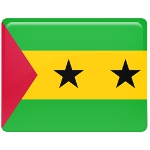Independence Day in São Tomé and Príncipe Date in the current year: July 12, 2026
 Independence Day of the Democratic Republic of São Tomé and Príncipe is observed on July 12. On that day in 1975, the country gained independence from Portugal. Independence Day is a public holiday and a day off for most citizens.
Independence Day of the Democratic Republic of São Tomé and Príncipe is observed on July 12. On that day in 1975, the country gained independence from Portugal. Independence Day is a public holiday and a day off for most citizens.São Tomé and Príncipe is an island country located off the western coast of Central Africa. It comprises two archipelagos around the two largest islands that gave the country its name. With a population of approximately 200,000, São Tomé and Príncipe is the second-smallest sovereign state in Africa after Seychelles and the world’s smallest Portuguese-speaking country.
The islands of São Tomé and Príncipe have no indigenous population; they had been uninhabited until Portuguese navigators João de Santarém and Pêro Escobar arrived here in the late 15th century. São Tomé is believed to have been discovered on December 21 (Saint Thomas’s Day), 1471, and Príncipe on January 17 (Saint Anthony’s Day), 1472. The island of Príncipe was originally named Santo Antão after Saint Anthony, but it was renamed Ilha do Príncipe, which means “Prince’s Island”, a decade later to honor the Prince of Portugal.
The first successful settlements on São Tomé and Príncipe were founded in 1493 and in 1500, respectively. By the mid-16th century, the islands had become an important slave trade hub, as well as one of Africa’s major sugar exporters. However, competition between sugar-producing colonies eventually led to decline of sugar cultivation on the islands. In the early 19th century, Portuguese companies introduced two new crops, coffee and cocoa. The latter remains São Tomé and Príncipe’s most important crop until this day.
Although slavery in Portuguese colonies was officially abolished in 1876, plantation workers were being subjected to forced paid labor. Dissatisfaction with working conditions marked by sporadic unrest continued for decades and culminated in the Batepá massacre that occurred on February 3, 1953. Forros (native creoles of São Tomé) rioted because they believed that the Portuguese would force them to work as contract laborers. The unrest resulted in a bloodbath, in which hundreds of forros were killed.
This event is considered the first step towards the independence of São Tomé and Príncipe. The Movement for the Liberation of São Tomé and Príncipe (MLSTP) was founded in 1960 and quickly joined efforts with other African liberation groups fighting against the Portuguese colonial empire. After the 1974 Carnation Revolution in Portugal, the new Portuguese government agreed to grant its overseas colonies independence. Following a brief transitional period, São Tomé and Príncipe officially became a sovereign nation on July 12, 1975, with Manuel Pinto da Costa as its first president.
Independence Day is the national day of São Tomé and Príncipe. On July 12, various festivities are held throughout the country. They include, but are not limited to, official speeches, colorful patriotic parades, traditional dance, open-air concerts, theater performances, and other festive activities.
- Category
- Public Holidays
- Country
- Sao Tome and Principe
- Tags
- Independence Day in São Tomé and Príncipe, holidays in São Tomé and Príncipe, public holiday, national day